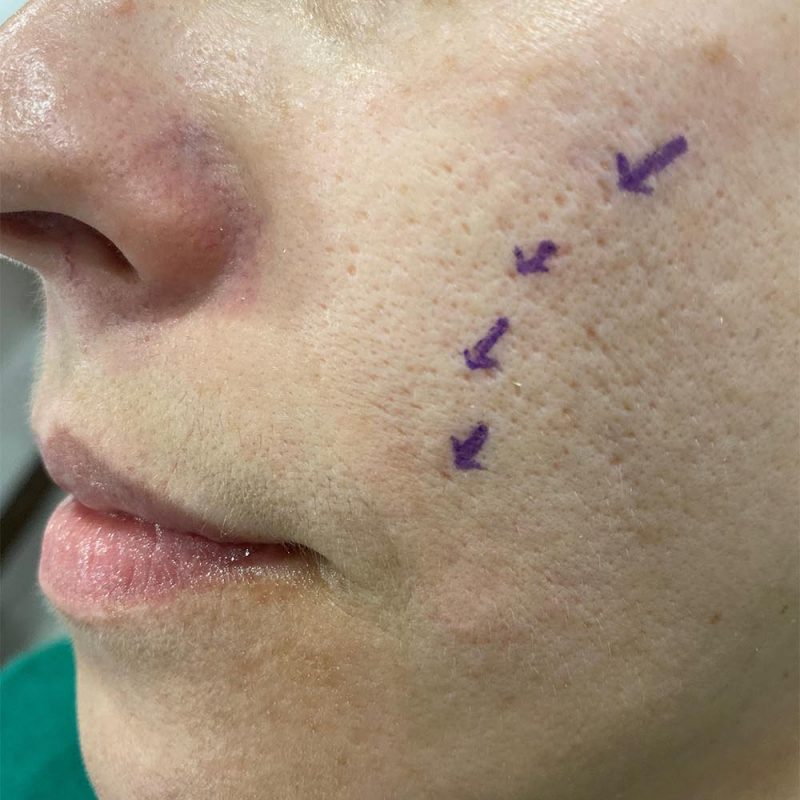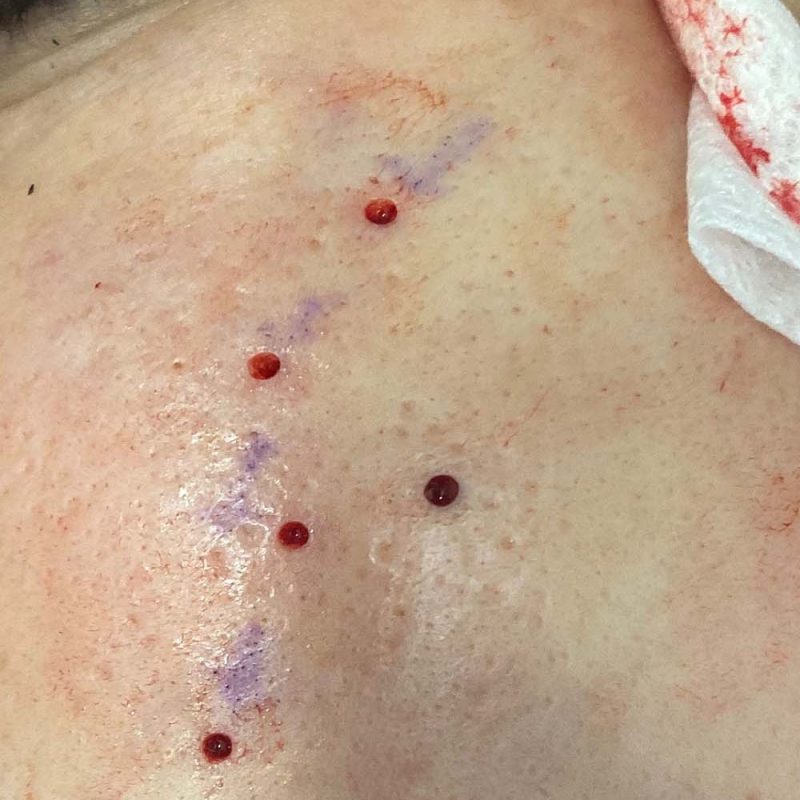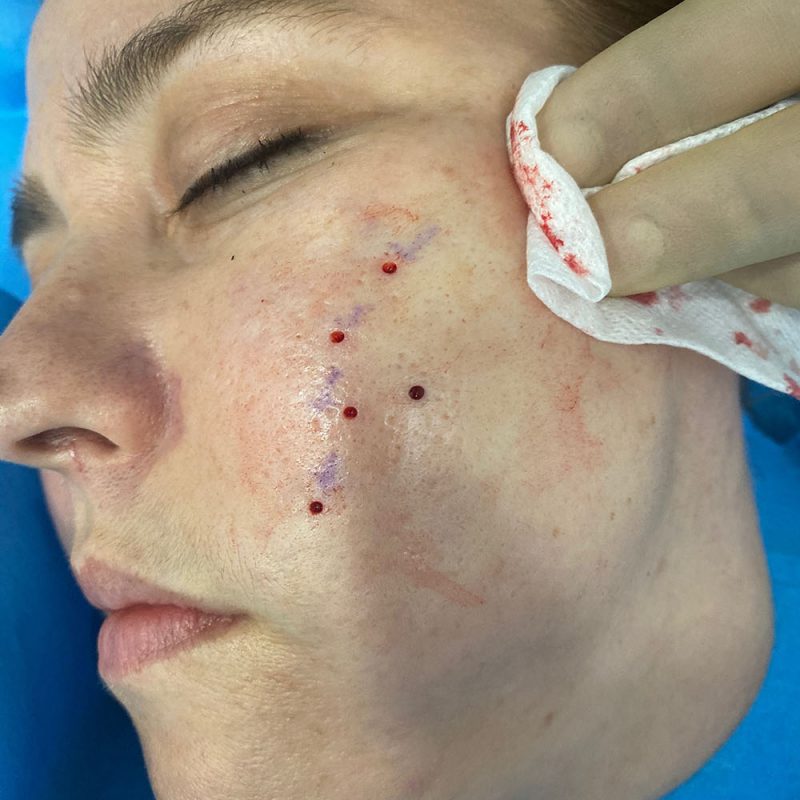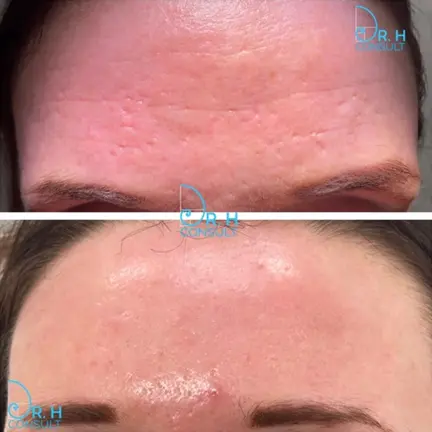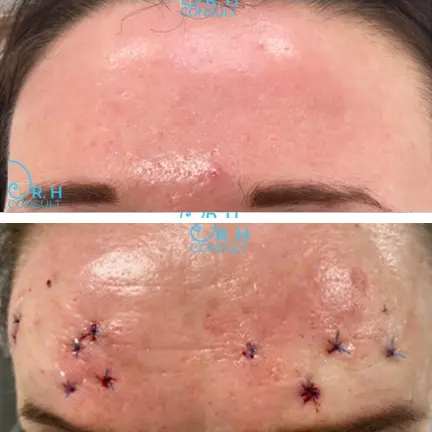Understanding Punch Excision
Using the technique of punch excision the acne scar is surgically removed through the use of a surgical tool that matches the size of the scar (ideally 1.5-3.5 mm). The remaining wound is closed with a stitch. Punch excision is an ideal technique for revising deep ice pick scars and narrow, deep boxcar scars (<3 mm). This can be a much faster and efficient way of resolving these more difficult scar types.
Many of the cosmetic problems faced by acne scar sufferers arise from the indentation and visibility of deeper scars. Punch excision effectively turns an indented scar or hole into a flat linear scar. These flat linear scars can then be further improved with laser resurfacing and the resulting minimisation in scar appearance will be much more cosmetically acceptable. The resulting modified scar would also be flat and easily disguised with a light layer of foundation or make-up.
One of the key reasons why DrH uses punch excision as a technique of choice for deep fibrotic boxcar scars and ice pick scars is because he also can modify the resultant scar with fully ablative laser within 4-6 weeks post punch excision surgery. The revised acne scar is now a small flat linear scar. Once this new smaller and flatter scar is resurfaced with full ablation the overall result will be a significant improvement over the original scar. This can be visualised in the before and after photos.
How is Punch Excision used in the management pathway for acne scars
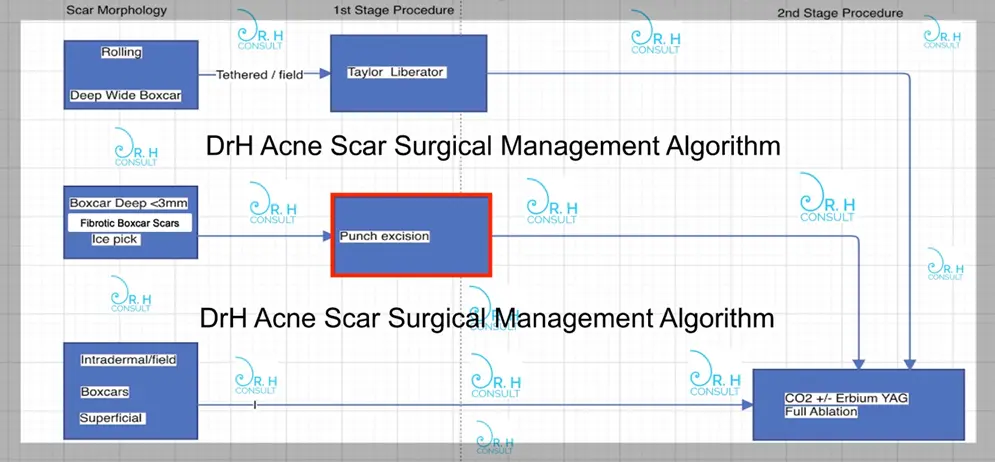
This is the stage of the acne scar management pathway illustrated above. It is highlighted in red. Dependent on the type of acne scar punch excision is a first stage procedure:
- For ice pick scars or narrow deep or fibrotic boxcar scars it is the first stage procedure that must be performed
- It can be combined in the same procedure with Taylor Liberator another technique that is used by DrH to release tethered areas of acne scarred skin.
- Taylor liberator subcision or Taylor Liberator combined with punch excision is usually followed by full ablation laser resurfacing. The full ablation resurfacing will be used to remodel the acne scarring that remains within the skin. Tethered skin released by Taylor Liberator Subcision and punch excision surgically removes the ice pick or deep narrow fibrotic boxcar scars. The remaining surgical punch scars and no tethered atrophic acne scars will then be dealt with in the second stage fully ablative resurfacing.
As always understanding which methodology relies always on appropriate classification of the scar type we are dealing with. This is why examination and appropriate diagnosis are essential first steps in managing acne scarring. Everything procedure that Dr Hussein does to manage your acne scarring is based on this.
Performing Punch Excision - How does Dr H perform the actual procedure?
During the punch excision procedure you will have the scars for punched examined and marked out with a surgical marker. DrH will then inject tumescent anaesthetic under the scars. The following two videos show a punch excision procedure in action.
The patient is awake and cannot feel a thing. After the procedure and anaesthetic wearing off there is no discomfort. The only discomfort associated with the punch procedure is the prick of the needle when injecting anaesthetic solution under the skin.
The photos show scars marked for punch excision and what these look like when removed from the skin.
Dr Hussein Case Gallery
Treatment at a Glance
Procedure Time
Allow 90 minutes total in clinic time
Number of Treatments
Typically a single treatment
Downtime
Fit for work in two days
Frequently Asked Questions
Your scars will be marked (scars to be removed are marked out with surgical marker pen) and tumescent anaesthetic injected. Following this you will be waiting around 20 minutes with the tumescent anaesthetic injected. After this wait time the punch excision will be performed.
Once the stitches have been placed and the procedure is complete you will be checked and fit to leave within 15 minutes of procedure completion.
The greater the percentage of ice pick or narrow deep boxcar acne scars the greater the degree of improvement.
A better idea of what this looks like can be gained by looking at cases where we have performed punch excision and laser resurfacing in the before and after phot gallery.
Swelling from anaesthetic injection will have resolved by the next day. Typically the only think felt during the procedure is the prick of the anaesthetic needle.
Following the procedure completion no significant pain is felt by the patient even after the anaesthetic has worn off. Normal activities can be resumed the next day.
The face must be washed twice a day with the facewash provided. Antibiotic ointment is applied to the stitches for three days. Following this plain Vaseline can be applied. No vigorous exercise for at least 3 days post procedure.
Stitches will be removed 2 weeks after the punch excision. Full ablation resurfacing will be performed within a 2-4 week interval following stitch removal.
- Swelling from anaesthetic injection lasting 24 hours
- Swelling from bruising, bleeding, inflammation lasting for a few days. If Taylor liberator Subcision is performed then recovery will be as described on the Taylor Liberator page.
Complications of this procedure are decribed at length in the consent and pre-reading literature but can be summarised as follows:
- Infection
- Wound dihiscence
- Bleeding
- Blood clot / Haematoma
Following this you can notify DrH of any unexpected problems using the ward round phone. This however is unlikely.
You will usually be booked in for your 2 week stitch removal appointment.
- Tumescent anaesthesia is slightly painful due to multiple small needle pricks
- Following the tumescent the procedure is pain free.
- After the procedure pain is not usually an issue. Opening the mouth wide or pressure can cause soreness in the first few weeks.
- The face should not be washed until the day after the procedure and is not painful
- Fece wash should be performed gently. Touching the face should be minimised or avoided.
- No face masks should be worn – these can get caught on stitches causing them to break
- If there is any significant pain after the procedure notify DrH via ward round phone
- Click on the booking form link
- Fully complete the booking form
- By giving us complete information you will help us appropriately assess your concerns
- Information is not used for any marketing purpose – It is essential medical information
- My team is small and busy and do not take random phone calls.
- Follow the booking form process and you will be duly contacted by Harriet. She will arrange your consultation.
- Following consultation your treatment can be booked. This is usually no earlier than 2 weeks following the consultation. This time is important to allow full consideration of the procedure by the patient. This is a part of the GMC guidelines and we strictly adhere to it. Exceptions can be made whereby international travel or mitigating circumstances require. However it is not something Dr Hussein encourages.
- Consultation is compulsory prior to treatment preferably in person but can be arranged online – Cost £200
- PUNCH EXCISION costs £2250
- COMBINED PUNCH EXCISION & TAYLOR LIBERATOR IN THE SAME SITTING – £2750
In mixed pattern scarring:
- If both Taylor Liberator and multiple punch excisions are required before resurfacing they can be combined into one procedure performed in a single session. Combined Taylor Liberator and Punch Excision costs £2750.
- Laser resurfacing will typically required after Taylor Liberator Subcision to treat the intradermal atrophic component of acne scarring. The cost of Full ablation Laser Resurfacing is £4250
Combination of procedures will be determined by examination during the consultation. If the consultation is online Dr Hussein requests well lit high resolution photos to be sent prior to consultation. From experience Dr Hussein can make a good judgement of what is required from photos. Absolute confirmation will be made on physical examination.
If punch excision is required there must be a window of maximum 4-6 weeks before full ablation is undertaken. This is because optimum results for the punch excision revision scars require full ablation to be performed within this time frame. This must be taken into account during the procedure planning process.
It is Dr Hussein’s usual practice to allow at least a 2-3 week gap between Taylor Liberator subcision and a 4-6 week gap between combined Taylkor Liberator and Punch Excision procedures (basically the punch excision standard gap of 4-6 weeks irrelevant of the Taylor Liberator subcision being performed or not) and resurfacing.
Why do we perform Punch Excision for acne scarring?
One of the key reasons why DrH uses punch excision as a technique of choice for deep fibrotic boxcar scars and ice pick scars is because he also can modify the resultant scar with fully ablative laser within 4-6 weeks post punch excision surgery.
The revised acne scar is now a flat linear scar. This can be seen in the photo below.
The photo shows some deeper boxcar scars that have been removed by DrH using punch excision.
The middle section of the photo shows the small linear scars 2 weeks after the punch excision.
The third part of this photo is an intraoperative photo. Here DrH demonstrates how he remodels the punch excision scar during full ablation.
The skin is pink as the epidermal layer has been removed during the first pass of fully ablative laser surgery.
So here we can see the punch excision scar within the dermis.
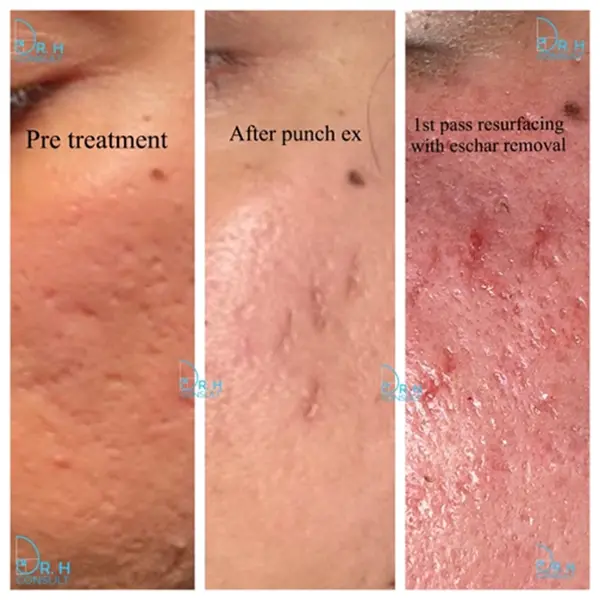
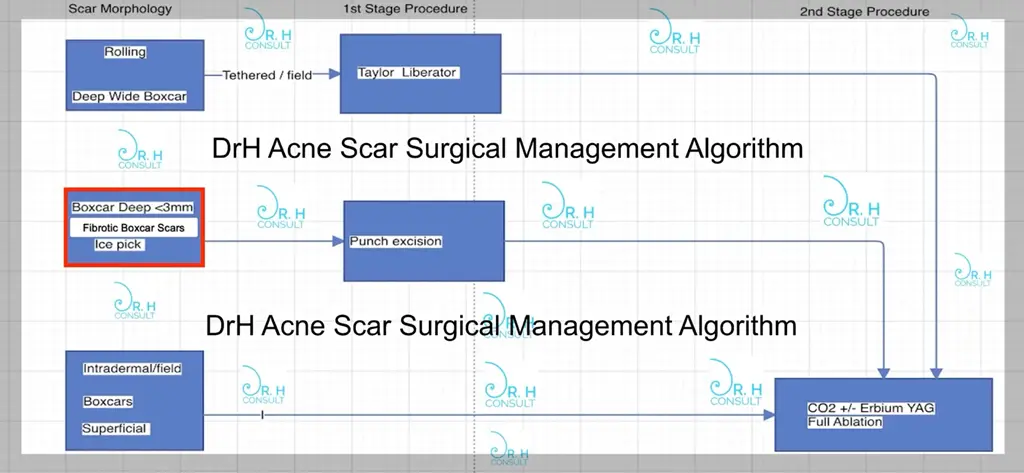
The next two photos show how things look once this fully ablative resurfacing is performed 4-6 weeks after punch excision. In the before and after split forehead photo the pre-treatment photo is showing a mixed scar pattern with ice pick and deep narrow boxcar scars on this patient’s forehead. The deeper narrow scars were punched. One can see in the photo next to it the scars that have been punched have non dissolving stitches for two weeks.
It is important to use non dissolving stitches because they do not interfere with wound healing and leave a better initial scarring result.
Once the stitches are removed full ablation CO2 laser has been performed at week 4 post punch excision. In the after photo in the split forehead photo one can see the result of punch excision and full ablation combined 3 months after the full ablation. As you can see. The forehead is much improved and areas where punches are performed are near invisible.
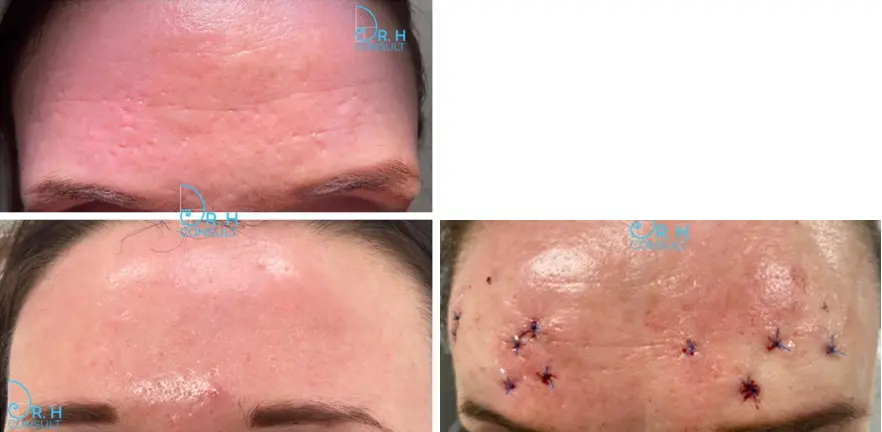
In short due to the fact that DrH uses punch excision as a first stage procedure followed by full ablation resurfacing 4-6 weeks after the punch excision he is able to treat these deeper narrow scars in one cycle of treatment.
The outcome of this treatment is much quicker and far more predictable than more basic methodologies such as TCA CROSS. TCA CROSS must be repeated every 3-4 months for several cycles. The outcome is generally better with TCA CROSS but sometimes the treatment can leave a wider scar.
DrHConsult is the only dermatological surgeon in the United Kingdom that can combine punch excision and full ablation laser surgery to perform a single cycle management solution that produces a consistent 70% plus benefit in ice pick and deep narrow boxcar scars. He has revolutionised the treatment of acne scarring nationally and globally using this advanced multimodal approach.
To have this type of treatment performed effectively and achieve the optimal result it is compulsory to have fully ablative laser performed on the resulting punch excision scars within 6 weeks to remodel the. The rationale for this is the same rationale we use in surgical scar management.
Once a punch excision is performed we have effectively performed a surgical scar revision of an acne scar. The resultant surgical scar must be remodelled with fully ablative laser once there is sufficient wound integrity. This optimum window for laser is between 4-6 weeks post punch excision.
It is the same principle for using laser remodelling in surgical scars. In order to achieve the best scarring result in a surgical scar such as a breast augmentation or abdominoplasty scar fractional or full ablative laser should be performed once there is sufficient wound integrity (usually between 4-12 weeks depending on various factors such as scar tension, size of scar, location of the scar on the body).
Why do we combine punch excision and full ablation at the 4-6 week interval?
It has now been understood for well over a decade that after any surgically created scar (e.g. Punch excision scars) laser should be performed within a 6 week period. DrH usually performs full ablation after punch excision at 4 weeks.
The rationale for this is that the punch excision scars heal quickly on the face and wound integrity and tension are sufficient to initiate full ablation at week 4. As can be seen from excerpt from the seminal article below published in the Journal of the American Academy of Dermatology (JAAD) in 2008.
The underlined section confirms that this fact was already understood before 2008.
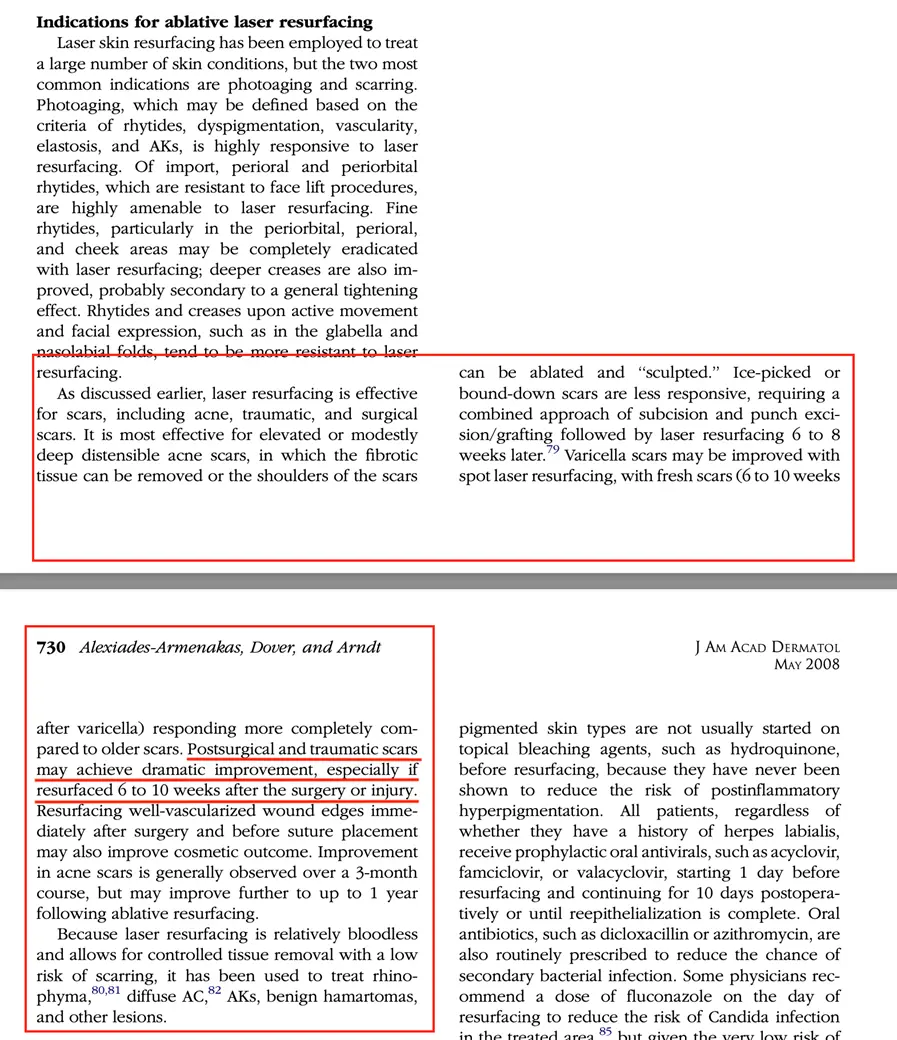
The technique is also discussed in this excellent visual summary. This article is available for free download by clicking on the link below. Please look at the section on acne scarring.
https://www.oatext.com/Acne-scar-management.php
As one can see DrH combines the two modalities on the basis of existing evidence. Results achieved by combining punch excision and full ablation are far superior to those that are achieved by punch excision alone. In general DrH will use this methodology as per the acne scar management pathway he developed. This is summarised in the flowchart at the top of this page. It is essentially a method he used for ice-pick scars and deep narrow boxcar scars up to 3mm in width.
Why is this issue hard to treat effectively often?
- Ice Pick and Narrow Deep Boxcar should be correctly identified and treated
- TCA CROSS (Chemical Remodelling Of Skin Scars) is slow and unpredicatable in result
- The best results with punch excision are achieved when full ablation is performed 4-6 weeks after
Only very few centres worldwide can perform deep full ablative resurfacing
- Where appropriate Taylor liberator Subcision should be performed along with punch excision
The key issue here is that there are very few centres worldwide that are dedicated to acne scar management. To effectively manage acne scarring comprehensive surgical techniques are required. This requires the skin surgery skills as well as advanced understanding and experience of lasers. It also requires specialist equipment. Most acne scarring in the UK is managed by aesthetic centres.
Acne Scarring is not an aesthetic problem. Acne scar surgery is reconstructive surgery. Acne is an inflammatory pathology of the skin and causes structural damage and deformity to the skin. Surgical acne scar management is required to appropriately correct the structural and anatomical abnormalities in the skin and sub skin tissues.
These procedures naturally are invasive. They require a high level of knowledge, training and experience. In order to be able to adequately provide this service a high volume of patients must be seen. This allows the surgeon to maintain his skill level and learn to minimise and manage complications.
Sixty seven percent of DrH patients come (from the UK and internationally) for advanced acne scar management. We can therefore truly say DrHConsult is a international leading centre for surgical acne scar management. DrH has enough case volume to be exceptionally proficient and safely carry out procedures such as fully ablative resurfacing, Taylor Liberator Subcision and scar revision/punch excision surgery. Most UK dermatologists would struggle to show a significant volume of acne scar management cases performed. DrH can treats the most acne scar cases in the UK. This is a fact. Acne scar management. It is what we do.
Punch excision vs TCA CROSS - Why does DrH prefer Punch excision followed by Full Ablation?
If we look at the table below we can see the various advantages and disadvantages of both methods. It is not about one method being better than another. Neither methodology is right or wrong.
DrH philosophy is a high improvement and aggressive procedure that is aggressive but requires a single round. Cumulative recovery and downtime being therefore overall less. Improvement is permanent and as long as no future acne issues further treatment is not required.
Other factors will come into play:
- Patients may not have the benefit from adequate downtime
- Surgical management associated with higher risk
- Not many centres offer punch excision and full ablation combined.
- Information supporting decision making is hard to find
- Consultation may have a bias towards the service that is offered
Due to the high level of expertise required in surgical acne scar management we concentrate our efforts here. Of course we know how to advise the patient comprehensively nut it is important to understand that DrH acne scarring practice centres around the Taylor Liberator Subcision / Punch Excision / Full Ablation Laser model and pathway that he has created. To maintain his expertise he focuses on surgical acne scar management methodology.
| Punch Excision & Fully Ablative Laser | TCA Cross |
|---|---|
Advantages
| Advantages
|
Disadvantages
| Disadvantages
|
The importance of Taylor Liberator Subcision combined with Punch Excision
Most acne scar patients present with a mixed pattern of acne scarring. This will include tethered scars, rolling scars, narrow deep boxcar scars in varying proportions. Usually there is a more predominant scar type concurrent with the pathophysiology of the original acne variants that caused the scars.
Often DrH combines techniques based on examination and type of scarring present. Where a significant element of subdermal tethering is present this may cause slight compromise in the punch excision result. DrH will be able to ascertain this from examination. Tethering can cause problems with closure of the punch scars. If punch excision is performed over a significantly tethered area of the cheek then closure of the skin is inhibited or put under tension by the fibrous tethering and may lead to traction on the punch excision scar. This in turn can lead to widening of the punch scar and suboptimal appearance.
By performing release of fibrous tethering just prior to punch excision the skin can be closed easily and without tension or traction due to the surgical undermining effect of the Taylor Liberator Procedure. This leads to a much more straight forward wound closure and improved punch excision result. This is why DrH often recommends combined Taylor Liberator and Punch Excision in order to make sure the global result and improvement is maximised.
How can we evidence our approach is better?
Please read the following publication:
Alexiades-Armenakas MR, Dover JS, Arndt KA. The spectrum of laser skin resurfacing: nonablative, fractional, and ablative laser resurfacing. J Am Acad Dermatol. 2008 May;58(5):719-37; quiz 738-40. doi: 10.1016/j.jaad.2008.01.003. PMID: 18423256.


